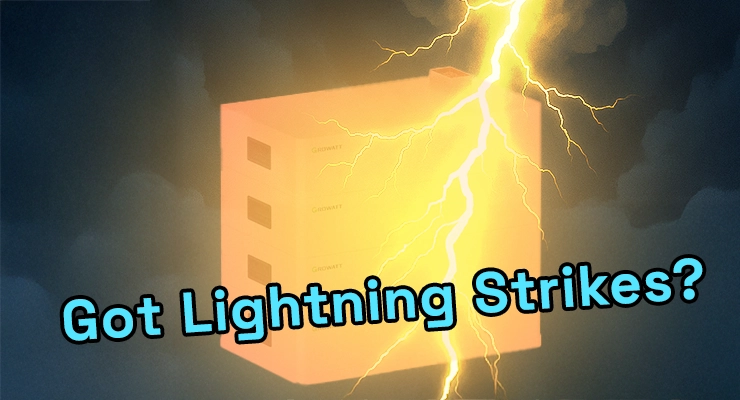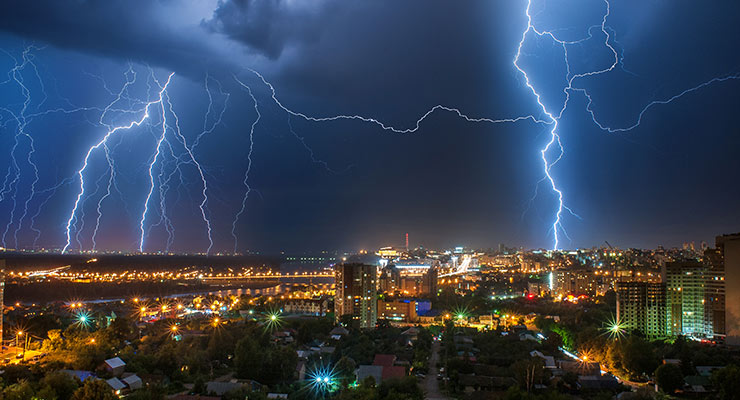Fast read
Your home battery system has multiple layers of defence against common power surges, managed by the inverter and mandatory electrical safety devices. For significant events like a nearby lightning strike, dedicated Surge Protection Devices (SPDs) installed in your switchboard are essential. A compliant installation by an accredited professional is the most critical factor in ensuring these systems protect your investment.
How do batteries handle power surges or lightning strikes?
As you invest in a home battery, it’s completely understandable to wonder how this significant piece of technology stands up to the unpredictable forces of power grid fluctuations and severe weather. The good news is that modern battery systems are designed with multiple safeguards. However, relying on these alone isn’t enough; a comprehensive protection strategy is key to true peace of mind.
This article explains what power surges are, shows how your battery system handles them, highlights the specific risks of lightning, and outlines the key steps you need to take to protect your system properly.
What is a power surge, and how can it damage a battery?
A power surge, or transient voltage, is a brief, sudden spike in your home’s electrical voltage. Most of us think of lightning, but surges are far more common than you might expect. They can be caused by:
- Grid switching: Routine operations by your electricity network provider can send small surges down the line.
- High-power appliances: The start-up of large appliances in your home, like air conditioners or pumps, can create internal surges.
- Faulty wiring: Issues within the home’s wiring can lead to voltage instability.
- Nearby lightning strikes: A strike near your property can induce a massive and destructive surge into power lines and the ground.
These events send a wave of excess voltage through your wiring. For a sophisticated electronic device like a home battery or its inverter, this is a major threat. The delicate internal components are designed to operate within a very specific voltage range. A significant surge can overload and “fry” these sensitive circuits, leading to costly repairs, system downtime, and potentially voided warranties. The inverter, which is the brain of your solar and battery system, is particularly vulnerable.
Your system’s first lines of defence: The inverter and built-in protections
Every compliant Australian solar and battery system has inherent protection mechanisms designed to handle minor electrical fluctuations.
Modern hybrid inverters are the intelligent heart of your system. They not only convert DC power from your solar panels and battery to AC power for your home, but they also constantly monitor the flow of electricity. High-quality inverters, such as those from reputable manufacturers like Sungrow, have built-in capabilities to manage minor surges and shut down if they detect a significant grid anomaly, protecting both the inverter itself and your battery.
Furthermore, Australian standards like AS/NZS 4777.2 mandate that inverters must be able to disconnect from the grid during a power outage. This “anti-islanding” protection is primarily to keep line workers safe, but it also helps protect your system from the potentially unstable voltage that can occur when the grid goes down or comes back online. The standard requires this disconnection to happen within two seconds of a grid anomaly being detected.
The essential extra layer: Surge Protection Devices (SPDs)
Inverters offer a solid baseline of protection, but they can’t handle the massive energy from major surges, especially those caused by lightning. That’s why you need a dedicated Surge Protection Device (SPD).
An SPD is a device installed in your switchboard by a licensed electrician. Its sole job is to detect a transient voltage spike and, in a fraction of a second, divert the excess energy safely to the earth. This prevents the damaging voltage from ever reaching your inverter, battery, and other sensitive household appliances.
In Australia, the installation of SPDs for solar and battery systems is guided by standards such as AS/NZS 5033 and AS/NZS 5139. There are different types of SPDs offering tiered protection:
- Type 1 SPDs: These are installed where power enters your property and are designed to handle the high energy from a direct or nearby lightning strike.
- Type 2 SPDs: The most common type for residential settings, these are installed in the main switchboard to protect against surges from the grid and internal events. Many modern inverters, including models from Sungrow, now come with Type 2 SPDs integrated on both the AC and DC sides.
- Type 3 SPDs: These are the familiar power boards with surge protection, offering a final layer of defence for specific appliances. They are not a substitute for Type 1 or 2 protection.
Installers should fit SPDs on both the AC side (covering your home and grid connection) and the DC side (linking your solar panels, inverter, and battery) to fully protect a solar and battery system.
The unique threat of lightning
A direct lightning strike is an incredibly powerful event that no residential surge protector can fully defend against. Thankfully, direct strikes on homes are rare. The more common threat is a nearby strike, which can induce powerful surges into underground and overhead power lines, causing widespread damage.
This is where a professionally installed earthing (or grounding) system and a comprehensive SPD strategy are your best defence. By providing a safe path for the immense energy to travel to the ground, you can significantly mitigate the risk of damage to your battery and other home electronics.
Questions to ask your installer
A compliant and safe installation is the single most important factor for protecting your battery. Your Solar Accreditation Australia (SAA) accredited installer is your best resource. Here are some crucial questions to ask them:
- Does your quote include whole-home surge protection (a Type 2 SPD) for both the AC and DC circuits?
- How will you ensure the system’s earthing is compliant with Australian standards (AS/NZS 3000 and AS/NZS 5139)?
- Can you explain the specific surge protection features of the inverter you are recommending?
- Are there any additional measures we should consider for lightning protection based on our location?
The final word: Protection is a system, not a single device
Your home battery isn’t left exposed to surges. A coordinated system protects it—led by the intelligence of the inverter, the built-in safety disconnects, and, most importantly, the Surge Protection Devices your installer places in the switchboard. While no system can offer a 100% guarantee against a direct lightning strike, a compliant installation by an accredited professional gives you the highest possible level of protection against the vast majority of electrical threats.
Investing in robust surge protection isn’t just about safeguarding your battery; it’s about protecting your entire home and ensuring your renewable energy system provides reliable, clean power for many years to come.





